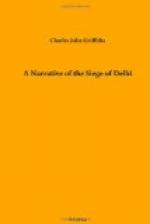No. 1 Battery, to our right front, consisting of ten heavy guns and mortars, was traced, on the evening of September 7, about 700 yards from the Mori bastion. No. 2, to the left front, near Ludlow Castle, and only 600 yards from the walls, was completed on the 10th, and contained nineteen pieces of artillery.
No. 4, for ten heavy mortars, and near No. 2, at the Koodsia Bagh, was completed in front of the Kashmir bastion also on that day. And, lastly, No. 3, on the extreme left, with six guns at the short distance of 180 yards from the Water bastion, was unmasked behind the Custom-House, which was blown up after the completion of the battery.
Thus, in four days and nights, after incredible exertions on the part of the working parties, forty-five heavy guns and mortars were in position, strongly entrenched, and ready to silence the fire from the enemy’s bastions and to make breaches in the walls for the assaulting columns.
The rebels during all this time plied the covering and working parties with shot and shell, bringing out field-guns, which enfiladed the Ludlow Castle and Koodsia Bagh batteries, and keeping up a sharp musketry fire from an advanced trench they had dug in front of the walls. At the two latter places, where the men of my regiment were employed, the fire was very galling at times, the guns from the distant Selimgarh Fort, Water, and Kashmir bastions all concentrating their shots at those batteries whi1st in process of erection.
The nights, fortunately, were clear, and we had plenty of light to assist us in our work; the men were cheerful and active, never resting for a moment in their labours, and receiving in the Field Force orders the praise of the General in command.
We wondered how it was that the enemy allowed us to occupy the advanced positions at Ludlow Castle and the Koodsia Bagh without even so much as a struggle; but it was accounted for by the supposition that they imagined our attack would be made from the right of our position, where all the great conflicts had taken place. There they were in strength, and it was our weakest point; whereas, on the side near the Jumna, we were protected from being turned by having the river on our flank, better cover for operations, and, moreover, batteries to silence which were less powerful and more difficult of concentration than those which faced us on our right from the city walls and from the suburb of Kishenganj.
[Footnote 1: White people.]
[Footnote 2: Lieutenant Pattoun was wounded in the ankle on this occasion, and a sergeant of the 61st was shot through the head.]
[Footnote 3: Colonel Seton, 35th Native Infantry, was wounded in the stomach in this affair.]
[Footnote 4: One man of the 61st Regiment was killed by a round-shot, which in its course also knocked over some sandbags which sent Lieutenant Hutton flying about seven feet.]
[Footnote 5: Lieutenant Yonge.]




